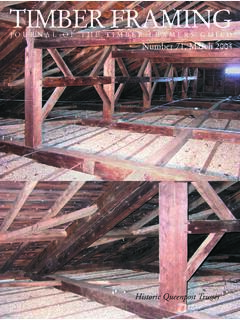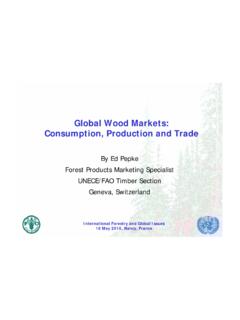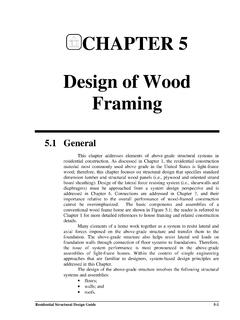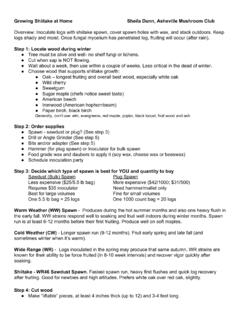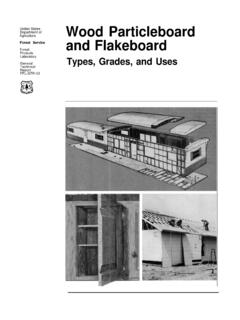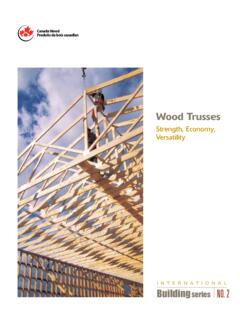Transcription of Historic American Timber Joinery: A Graphic Guide| 2004-08
1 Historic American Timber Joinery: A Graphic Guide| 2004-08 Historic American Timber JOINERYA Graphic GuideBy Jack A. SobonWith illustrations by the authorPublished by the Timber Framers Guild, PO Box 60, Becket, MA 01223 Edited by Kenneth Rower, Director of Publications 2002 Second Printing 2004 FOREWORDTHE six chapters that follow discuss and illustrate the joints in American traditionaltimber-framed buildings of the past, showing common examples with variations as wellas a few interesting regional deviations. The discussion does not describe the cutting ofthe joints (that is best left to the how to books), but may mention whether a joint issimple to fashion or labor intensive.
2 Structural merits are discussed only in general of the research underlying the articles was done in the heavily Timber -framedNortheast, but the findings are applicable over a much wider area. The material wasdeveloped under a grant from the National Park Service and the National Center forPreservation Technology and Training. Its contents are solely the responsibility of theauthor and do not represent the official position of the NPS or the NCPTT. The mate-rial appeared originally as articles in Numbers 55-60 of Timber FRAMING (ISBN1061-9860), the quarterly journal of the Timber Framers the six chapters illustrate common as well as unusual Timber joineryfound in old structures, the catalog necessarily remains incomplete.
3 Some of theillustrations used in this series had appeared previously in Timber FRAMING, andFig. 1 of Chapter 1 appeared in my Build a Classic Timber -Framed House (see bibliogra-phy at the end of this volume).I wish to thank the following organizations and individuals who have generouslysupplied assistance, information or access to buildings: Hancock Shaker Village, theNational Center for Preservation Technology, the National Park Service, the TimberFramers Guild, Chris Albright, Richard Babcock, Will Beemer, Leslie Bird, Rolf Briggs,Rudy Christian, Abbott Lowell Cummings, Peter Haarmann, Greg Huber, Don Johnson,David Lanoue, Jan Lewandoski, John MacFarland, Paul Oatman, Ed Ondrick, KenRower, Peter Sinclair, Lawrence Sorli, Arron Sturgis, Marc and Wendi Volk, DickWarner, Rob Williams and Preston Woodburn.
4 Jack A. Sobon, Windsor, Massachusetts, December 2002 ISBN 0-9706643-2-XAnchorbeams and Anchorbeam Tenons 6, 7 Axial Compression and Tension46 Barefaced Tenon28 Bending 46, 47 Beveled Lap29 Birdsmouth 34, 35, 39 Bladed Scarfs 46, 47, 49 Blind-Housed Through Mortise and Tenon 4 Blind Mortise and Tenon 20, 21 Boarding Grooves 9, 16 Bridled Scarfs 49, 50 Broken Back Roof43 Butt Cog22 Canted Purlin Plate40 Cantilevered Plate14 Ceiling Joists 26, 27 Chase Mortise 26.
5 27 Cogs and Cogged Joints 12, 15, 22 ,47,48 Common Purlins 42, 44 Common Rafters34 Corbels 32, 33 Diminished Haunch25 Diminished Housing 3 Diminished Shoulder 10,17, 30 Dovetail Tenons 5 Draw Bore14 English Tying Joint 8, 9,10,17,18,19 Flush Lap Tying Joints10 Flying Plate 17, 18 Floor Joists and Girders22 Free Tenon 50, 51 Full-Housed Mortise31 Half-Housed Mortise31 Halved Scarfs47 Halved and Tabled Scarfs48 Hip Purlins44 Housed Mortise and Tenon24 Intermediate Sill Girder Joints 21, 22 Interrupted Plate16 Inverted Lapped Full Dovetail21 Joining Structures 50, 51, 52 Jowls 8, 9, 52 Kerf-Wedged Dovetail Through Mortise and Tenon 6 Knees33 Kopbalkgebint 6 Lap Dovetails10 Lapped Brace32 Lapped Half-Dovetail21 Lean-to Rafters43L-Mortise26 Lookout41 Moment 46.
6 47 Mortise and Tenon14 Necked Tying Joint 6 Outriggers 17, 43 Packing Piece31 Paired Tenons26 Paired Through Mortise and Tenon 4 Passing Brace33 Peak Joint38 Pentice Roof 43, 44 Plank Sill22 Principal Rafter-Common Purlin Roof 41, 45 Principal Rafter-Principal Purlin-Common Rafter Roof 40 Pulley Mortise 26, 27 Rafter-Plate Joints 34, 35, 36,37 Rafter-Purlin Plate Joints38 Rafter Tails 35, 36, 37 Raising Plate 10, 12, 17 Relish 2, 11, 16, 21 Ridge Beam38 Ridge Board39 Scribe Rule, Square Rule 3 Shear46 Short Joist26 Sill Corner Joints20 Sloped Tabled Corner Lap20 Soffit Tenon25 Splayed Scarfs 48, 49 Spurred Shoulder25 Squinted and Undersquinted Scarfs 47, 48, 49 Step-Lap 11, 13, 14, 36, 37, 39 Strengthened Halving24 Strengthened Tenon25 Stub Tenon28 Studs28 Summer Beam25 Tenoned Braces30 Tenoned Joists24 Through Mortise and Extended Tenon 6 Through Mortise and Tenon 2, 20 Through Mortise and Tenon with Dovetailed Shoulder 5 Torsion (Twisting)
7 46 Triple Bypass Joint16 Tusk Tenon25 Tying Joists23 Wedged Dovetail Through Mortise and Tenon 4 Whistle Cut48 INDEX TO JOINTS AND USEFUL TERMSTABLE OF CONTENTSI. Tying Joints: Tie below Plate 2II. Tying Joints: Tie at Plate 8 III. Sill and Floor Joints20IV. Wall and Brace Joinery Excluding Trusses34VI. Scarf Joints46 Photos and drawings by the author unless otherwise indicated . Bibliography, page 54. Joints: Tie belowPlateOF ALL the joints that make up a traditional timberedframe, the most important are the tying joints.
8 Tiebeams, also referred to as crossbeams, anchorbeams, tiesand lower chords (in trusses), are transverse horizontalmembers that span from wall to wall or eave to eave, resisting theoutward thrust of the roof planes. Where the tie beam joins the wallframing, we have the tying joint. Tying joints are usually the onlyconnections in a frame that must resist tension. When a tie beamjoins the feet of principal rafters, the result is a triangle, a rigid struc-tural shape. In wide structures, rafters are often supported by purlinplates somewhere in midspan, and their effective span is thus short-ened (see Fig.)
9 2). Support by purlin plates normally reduces outwardthrust of the rafter at the plate and consequently the load on thetying joint. But wind loads can cause bracing to exert tension loadson the tying joint. In aisled structures, the tie beams may not becontinuous across the entire width, but may span only from aislepost to aisle post. Of all the joints in a Timber frame, the tying jointsespecially must be of good structural design and each one well crafted(there is no redundancy).Because of their complexity and variety, tying joints may conve-niently be divided into two groups: tie below plate and tie at article will focus on the former tie below plate, or dropped tie as it is often called, joins thewall posts below the plate.
10 Its connections are generally simpler thanthose of the tie at plate and probably its configuration is the morewidespread. Since it lies below the plate, occasionally several feet,and the rafters join to the plate, it doesn t create the nice trianglewith the rafters that engineers like to see. The rafters carry roof thrustto the plate. The plate transfers the load to the posts. The posts arejoined by the tie beams. Each joint must be sufficient to carry theload, and the post must not the load path is convoluted, why did the arrangement arise?
